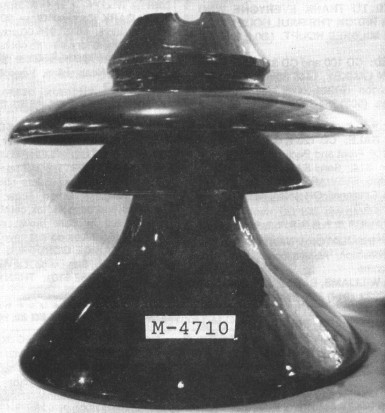Porcelain Insulator News
by Elton Gish, NIA #41
Reprinted from "Crown Jewels of the Wire", January 1990, page 7
Robert Stahr (NIA #4186) reported a very unusual rack type insulator shown in
his drawing at right. Robert said that only the bottom (shaded area) and the pin
hole are glazed. There are no markings of any kind and the glaze is a mottled
brown. I have not seen a rack type insulator with a standard pin hole.

I doubt
that this insulator would have been used exposed to the weather since most of
the outside surface is un- glazed. Do any of you have any ideas on this one?
Help!?
Milo Holland (NIA #627) wrote about a 3-piece insulator that he found at
a local flea market in Massachusetts (see photo top of next page). It is a new
multipart style for which I have assigned it M-3122. It is incuse marked
"THOMAS" underneath the top skirt with the following dimensions:
9 - 6 - 6 x 9
This M-3122 has a very pretty mottled brown glaze typical of Thomas
manufacture. However, there is another very curious marking which uses the same
size letters as the Thomas marking. The incuse marking "D.R.R.E." is
located upside-down on the side of the crown. Milo further states that another
one with identical markings was found in a swamp west of Fitchburg, MA. From the
style, I would guess that these were made during the 1910's. This is another one
which we could use help. Any ideas out there about the D.R.R.E. marking?
Mike Jordan (NIA #4209) writes about a very beautiful 4-piece insulator with
Ohio Brass logo marking on the crown. It is M-4326. I wish that we could print
his two photographs (shown below) in color as this insulator is one of the most
beautiful mottled black and tan O-B units that I have ever seen. The glaze is
very shiny. The actual dimensions (rounded to nearest 1/2"):
14.5 - 9 -
11.5 - 7.5 x 12.5
Mike says that he found this one about twelve years ago at a
plant nursery in San Antonio.
"The nursery had about 15-20 of these insulators turned upside-down and
being sold as flower pots. When I saw these 'flower pots', I thought they looked
very familiar. I inspected each one, picking them up and turning them over. I
was tired afterwards as they must have weighed at least 40 pounds each. I
finally found one that was mint and relatively clean. The nursery wanted $5 for
it."
Now what ever happened to those other "flower pots"?
The next photo is of a M-3230 sent in by Robin Harrison (NIA #1309). Robin
had sent me a roll of black-and-white film of various insulators in his
collection of which three were new styles for the M-Chart. The M-3230 in Robin's
collection is one of my favorites. I did manage to get one of these recently. It
is surprising to me how small they really are compared to catalog drawings and
photographs. They just appear to be larger. Robin's M-3230 is unmarked, but
made by Thomas during the 1910's.

I thought that you all might enjoy hearing
Robin's account of how he found the M-3230. I only wish more of you would share
your stories of insulator hunts. For those of us who are not fortunate enough to
go on successful hunts, we can only dream of the excitement. Many of us would
enjoy reading about your experiences even though it still is not as good as
being there. Robin's insulator hunt is quite different than most in that hunting
for multiparts often requires much more strength and stamina than hunting for
glass [Have you ever carried multis for four miles?], and a great deal more
thought for safety when exploring around old power plants.
"Last summer a few of my collecting friends and I took a trip into
Canada and eastern Washington. After visiting Canada, we returned via eastern
Washington. After some exploration in the northern part of the state, we visited
a lineman who was an acquaintance of one of my traveling companions. He gave us
a tip about an old abandoned, and soon to be demolished, hydro plant on a nearby
river. We scouted the plant from across the river, and saw a few insulators, but
it was getting late in the day and we needed to camp and head back to Seattle
the next day. After some debate, the insulator bug bit, and we decided to make a
quick exploration.
We needed to park about four miles away and cross an
abandoned railroad bridge, then we jogged in to beat the dark. The place was
really neat, with the turbines still in place, and worse yet, it was the local
shooting gallery. The insulators were 90% blasted apart. I spotted the M-3230 on
a rotted cross-arm outside the building, about 20 feet up. It was one of the few
partly intact insulators on the exterior.
I felt that the crossarm was too
rotten to get the insulator, and I went inside to look around. Fortunately, some
M-3060's were still up on a crossarm about 20 feet above the floor on a massive
timber near the roof. I managed to climb up the wall (using my rock climbing
skills) and onto the beam to retrieve one unmarked and two Victor M-3060's.
Unfortunately, one of the marked specimens broke while trying to get them down
to the ground. Against all of the laws of luck, the nicest one, an orange mint
specimen survived, and it was the prize of the exploration. I then climbed to
the roof and looked out over the timber with the M-3230 on it. It was so
tempting because the color was a nice streaked beige and orange, but it had some
damage.
The M-3230 appeared to have been used on a bus of some kind as it had a
metal tube attached to the crown. I discovered that the crossarm timber was held
by two bolts onto the building, and I could loosen them and swing the timber
loose. The operation was a gamble with low chance of success, because the other
end of the beam was above a rock outcrop. The beam was far too heavy to let
anyone be around when it dropped.
By this time, everyone was anxious to get back
before dark. The crossarm came down perfectly and cracked in half at the rotten
part. The bus tube held the insulator upright away from the rocks. The hike back
to the car with a bunch of hardware and multiparts is best left to history.
There must have been 10 to 12 M-3230's in use on the bus structure, but this was
the only survivor. The hydro plant was dated from the 1930's, so these must have
been salvaged from somewhere else. The plant is probably gone by now."
Now for the big surprise. The jewel pictured at the top of the next page is
the largest, by overall dimensions, of any known pin-type insulator. It made an
appearance on Saturday at the Allentown National, and it stole the show, at
least for porcelain. Chris Hedges snatched this one up for his collection months
before the show, so all the rest of us could do was to drool and get our picture
taken with it. The Gordon's (Miss Beehive and Wes) guarded this jewel for Chris
until they could deliver it to him in Kansas City. Miss Beehive had
appropriately attached a small boat to the crown as a symbol of the ultimate
"boat anchor".
I have assigned this jewel M-4710. The fourth shell is recessed inside the
huge bottom skirt. The insulator was unmarked, but my crystal ball says that it
was made by the Lima Insulator Co. which was in business from 1904 to 1908. The
glaze characteristics and color are identical to the marked Lima M-2640's that
were found in Alaska. Jeff McCurty found this insulator 15 to 16 years ago in an
antique shop in the Adirondacks of upper New York. Wouldn't you love to see a
line outfitted with these big jewels?
For those of you that are avid multipart
collectors, I hope that you were able to attend the Allentown National. If not,
you missed the greatest excitement in multipart collecting in the history of the
hobby. That show had the greatest variety of multipart porcelain insulators, and
more collectors chasing them, than at any other show. This truly is the age of
multipart porcelain insulators.

NOTE: The fine article on the CD 241 Locke which appeared in last month's
issue was written by Elton. He always sends his articles "camera
ready." I overlooked the fact that his copy did not include mention of his
authorship. Thank you to those out there who wanted to know who had compiled the
excellent story.
| 